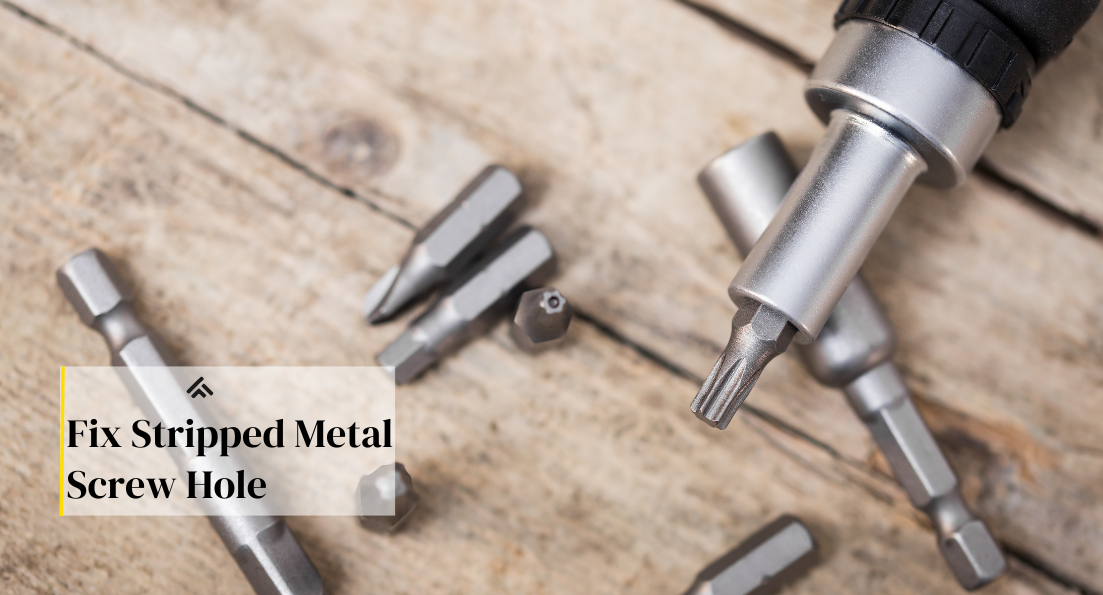Are you constantly struggling with stripped metal screw holes in your DIY projects? It can be frustrating when a seemingly simple task becomes a major setback due to these pesky little holes.
Not only do they make it impossible for you to securely fasten screws, but they also compromise the structural integrity of your project. But fear not, as there is a solution to this problem.
I will dive into the world of fixing stripped metal screw holes and how utilizing professional Metal Cost-Estimating Services can save you time, money, and stress. So if you’re tired of dealing with flimsy screws and weak joints, keep reading to learn how to fix those stripped metal screw holes once and for all.
Step-by-Step Guide on How to Fix Stripped Metal Screw Hole
Fixing a stripped metal screw hole can be frustrating, but there are several methods you can try to solve the problem. The right approach often depends on the material’s thickness and the screw’s size. Here are some common methods to fix a stripped metal screw hole:
Use a Larger Screw
If the hole isn’t significantly enlarged, you might be able to fix the issue simply by using a slightly larger screw. Ensure the new screw has a similar thread type but a larger diameter. This is often the simplest and quickest fix. When selecting the new screw, consider the material of the surface being screwed into to avoid any compatibility issues. Additionally, gently widening the hole with a drill may also help accommodate the larger screw for a more secure fixing.
Fill the Hole and Redrill
When encountering holes that cannot be easily repaired with a larger screw, a practical solution is to fill the hole with an appropriate filler material. Once the filler sets, the next step is to carefully redrill the hole to accommodate the original screw size, ensuring a secure and effective fix.
Metal Epoxy:
Apply a metal epoxy filler into the hole, ensuring it fills the void. Follow the manufacturer’s instructions meticulously for accurate mixing ratios and adhere to the specified curing times for optimal results. Once the epoxy is fully cured and hardened, proceed to drill a new pilot hole at the designated spot and carefully reinsert the screw, ensuring a secure and lasting fix.
Thread Repair Epoxy:
Similar to metal epoxy, thread repair compound is a specialized adhesive specifically formulated for fixing damaged threads. Packaged in a convenient syringe, this compound offers easy application directly into the threaded hole, providing a reliable solution for thread repair projects.
Use a Threaded Insert or Helicoil
For a more lasting and robust solution, particularly crucial for high-stakes applications, one effective approach is to utilize a threaded insert or a Helicoil. These methods provide added durability and reliability, ensuring the integrity of the assembly over an extended period of use.
Threaded Inserts:
These metal tubes, known as threaded inserts, come with internal threads for insertion into stripped holes. If the hole doesn’t match the insert size, drilling it to a larger dimension is necessary before employing a specialized tool for installation.
Helicoil:
A helicoil, a helically coiled wire insert, is utilized to create a new threaded surface for a screw. The installation process includes drilling the hole to a specified size, tapping the hole with a larger thread to accommodate the helicoil, and finally, securing the Helicoil in place. This method effectively restores stripped or damaged threads, providing a reliable and durable fastening solution.
Tap to a Larger Size
If the other options are not suitable or available, one alternative to consider is tapping the hole to a larger size and using a screw that fits the new thread. This approach involves utilizing a tap and die set, which are tools designed for creating or repairing screw threads. Having some basic knowledge of how to properly use these tools is crucial for successful implementation.
Use a Screw Repair Kit
There are specialized screw repair kits readily accessible in the market, meticulously crafted to address the issue of stripped threads. These comprehensive kits typically encompass an array of essential tools and materials, including taps, dies, and inserts, meticulously tailored to cater to various common screw sizes. These kits provide a convenient and effective solution for individuals seeking to rectify stripped threads with precision and ease.
The effectiveness of these repairs can depend on the specific situation, including the type of metal, the size of the original and new screws, and the load on the screw. Sometimes, if the structural integrity is critical, replacing the entire part may be the safest option.
To read more articles visit ToppersBlogs
Conclusion
Fixing a stripped metal screw hole may seem like a daunting task, but with the right tools and techniques, it can be a simple process. The key is to first assess the severity of the damage and choose the appropriate repair method. Whether it’s using wood filler for small holes or tapping in a threaded insert for larger ones, there is a solution for every situation. It’s also important to take your time and be patient when working on these types of repairs, as rushing can often lead to further damage. And don’t forget to use the proper safety precautions when handling power tools or working with metal hardware. Taking care of these repairs not only saves you time and money from having to replace the entire piece, but it also gives you a sense of accomplishment knowing that you were able to fix it yourself. So next time you come across a stripped metal screw hole, don’t panic follow these tips and you’ll have it fixed in no time!


